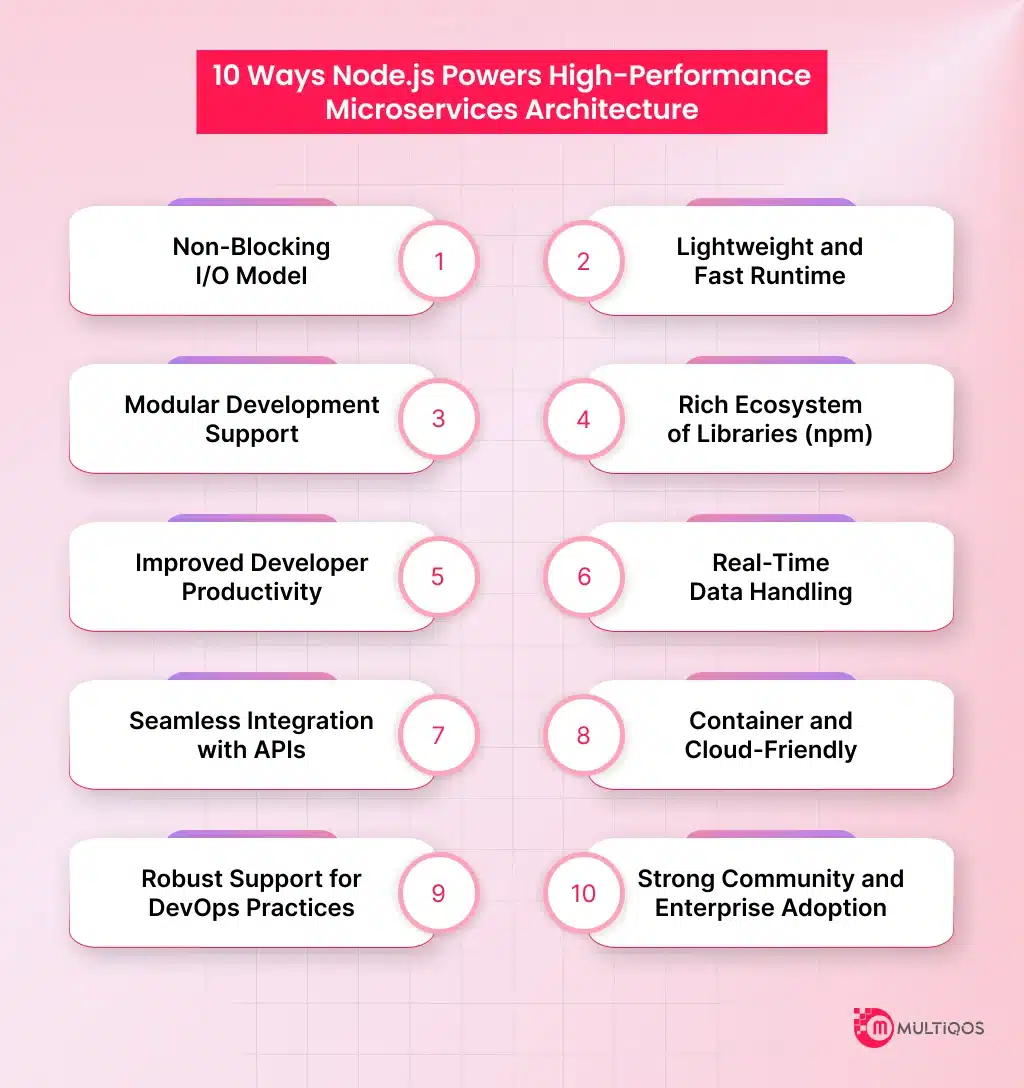How Node.js Powers High-Performance Microservices Architecture?

Summary :
This blog explores how Node.js and microservices work together to create high-performance, scalable application architectures. By leveraging Node.js’s non-blocking I/O, lightweight runtime, and modular development style, teams can build efficient, independent services that are easy to scale and maintain.
The article highlights key benefits such as improved concurrency handling, real-time capabilities, fast deployment, and seamless API integration, making Node.js a top choice for modern microservices architecture. In this blog, we will cover how Node.js empowers microservices, its key benefits, and best practices for building high-performance distributed systems.
Introduction
Developing high-quality, maintainable, and scalable applications is no longer a choice, but rather a requirement in today’s seamless digital world. Modern development teams aiming to break down monolithic systems into agile, decoupled Microservices Architecture employ the Microservices architecture. Supporting it with the right technology stack is crucial. And this is where Node.js shines.
The non-blocking event-driven architecture of Node.js enables its use in developing microservices with high scalability, speed, and optimal resource utilization making it among the most popular technologies.
This blog discusses the ways in which Node.js development enhances microservices architectures, showcasing their efficiency in distributed systems with high performance.
Why Use Microservices with Node.js?
1. High Performance and Scalability
Node.js’s non-blocking, event-driven architecture has the ability to handle numerous requests simultaneously. These functionalities allow for horizontal resizing of Node.js with microservices, maximizing the traffic volume of an application to handle it without latency or loss of speed.
2. Faster Development and Deployment
Node.js’s rapid development capabilities are attributed to the lightweight Node.js runtime and its extensive npm repositories. The independent development, testing, and deployment of Node.js with microservices facilitates accelerated release cycles and minimized time-to-market.
3. Efficient Resource Utilization
Due to its non-blocking I/O, Node.js uses fewer resources than other multi-threaded platforms. More applications can run on the same framework, which improves system utilization and cost-efficiency.
4. Enhanced Developer Productivity
Given that JavaScript is a popular language, Node.js employs it at every level of the stack. This aids in a reduced learning curve and allows full-stack developers to easily transition between frontend and backend services, enhancing team collaboration and productivity.
5. Easy Integration and Interoperability
Node.js with microservices can interact with different services written in other programming languages via REST APIs or messaging protocols. The characteristics above stress the need for more advanced solutions in systems with heterogeneous structures.
10 Ways Node.js Powers High-Performance Microservices Architecture
Here are the 10 ways to showcase how Node.js powers high-performance microservices architecture, have a look:
1. Non-Blocking I/O Model
Node.js is basically dependent on an architectural design, which is an event-driven, non-blocking I/O model. Unlike traditional multi-threaded frameworks, Node.js employs a single-threaded architecture where asynchronous I/O operations are performed in an event loop. In an environment where diverse services must be accessed in a rapid and resource-efficient manner, as is the case in microservices, this architecture is responsive while maintaining low latency during heavy usage.
2. Lightweight and Fast Runtime
The V8 JavaScript engine from Google compiles and executes Javascript as machine code, enabling its rapid performance. Node.js runtime is also non-bulky, consuming fewer resources when put next to non-virtual server frameworks. Due to this characteristic, it is inclined towards microservices that are designed to be petite payloads spatially efficient in starting, and using system resources, especially in container or serverless environments.
3. Modular Development Support
Node.js with Microservices consists of creating apps as a set of small, self-contained services. It encourages modularity which allows programmers to create uncluttered and structured code in reusable pieces. Each service can be built, tested, and deployed independently with Express.js or Fastify. Such division improves the system’s overall architecture, eases scaling, and minimizes cascading failure risks within the system.
4. Rich Ecosystem of Libraries (npm)
Node.js is installed with npm, the largest collection of libraries in the world, which are free to use. If you need an authentication system, logging console, HTTP client, or message broker, there is a good chance that it is already implemented using industry standards and best practices packaged as a module. This improves the speed of development, reduces repeat code, and allows for prototypical building blocks on day one for production-ready tooling and patterns within Node.js microservices.
5. Improved Developer Productivity
Writing scripts in JavaScript for both the client and server sides is one of the great advantages of Node.js. This consistency increases output, as productivity losses from context switching are reduced, and there is an increase in full-stack development where one team works on the whole codebase owing to enhanced productivity. This enables faster onboarding and improved inter-team collaboration with fewer bugs attributed to language variances.
6. Real-Time Data Handling
Node.js handles real-time information exceptionally well since it incorporates WebSockets and event streaming. Microservices built with Node.js can push updates to clients in real-time, control bi-directional communications, and provide live features with virtually no delays at all.
7. Seamless Integration with APIs
Communication between services—often through RESTful APIs or GraphQL—is one of the defining characteristics of microservices architecture. The existence of popular frameworks such as Express, Koa, and Hapi makes API generation and consumption trivial with Node.js. The middleware pattern makes plugging in authentication, logging, and rate-limiting easy. Services provided by Node.js can also easily make calls to external APIs such as payment processors or cloud storage services, which makes integration simple.
8. Container and Cloud-Friendly
The minimal memory and CPU requirements of Node.js are ideal for containerized systems where Docker is used or for orchestration systems such as Kubernetes. Node.js also has the advantage of starting quickly, which is beneficial in self-scaling systems, or serverless platforms such as AWS Lambda. Such cloud-friendly attributes enable enterprises to swiftly implement Node.js microservices within modern infrastructural configurations.
9. Robust Support for DevOps Practices
The design of microservices has become popular due to its emphasis on continuous integration and continuous delivery (CI/CD) automation along with resultant monitoring procedures. DevOps tools are easily integrated with Node.js which also supports build automation, testing, and deployment pipelines. It allows for the automated execution of unit tests, linting, and deployment scripts by developers. Automated unit tests, linting, and bug fixes lead to faster releases, a reduced likelihood of bugs, and accelerated feedback loops.
10. Strong Community and Enterprise Adoption
Companies like Netflix, PayPal, Walmart, and LinkedIn have integrated Node.js for microservices, showcasing active community support as well as vast usage from multiple enterprises. The enhancements, updates, and community support Node.js receives are due to its strong backing from industry experts as well as the myriad number of tutorials, tools, and documents available. Utilizing Node.js for microservices is choosing an enterprise-proven framework.
Conclusion
Node.js microservices architecture elements can be scaled to be very performant. Node.js productivity is at its best when building complex distributed systems due to its agile development cycles, DevOps-friendly ecosystem, and exceptional event-driven non-blocking I/O architecture. Its flexible architecture also comes from the lightweight runtime and extensive Node.js packages available, allowing parallel development of complex modern services that need to scale easily and cost-effectively.
Microservices systems must be built with expertise to withstand stress and be easily expanded. For an efficient, maintainable, and future-proof architecture, hire Node.js developers and achieve faster results with a talented team that handles the processes seamlessly.
Frequently Asked Questions
The event-driven, non-blocking I/O architecture of Node.js makes it perfect for concurrent request handling without delays. Developers can create scalable, autonomous microservices using its limited runtime and quick execution. This alleviates inter-service communication bottlenecks and maintains consistency in distributed systems.
Node.js is capable of managing thousands of connections simultaneously as it uses an event loop that runs on a single thread. Each request is handled asynchronously and does not require a thread to be created, which minimizes overhead. Managing microservices, which entails managing multiple operations, enables higher performance with the use of this architecture.
The key benefits are rapid development cycles, improved scalability, optimal resource usage, and npm’s rich ecosystem of packages. In addition, Node.js allows for better loose coupling between services and easier deployment, making it possible for teams to work on different microservices that do not impact the rest of the system. All of these considerations position it at the forefront of contemporary backend architectures.
Node.js’s interoperability is rather high since it can interact with systems developed in different languages using APIs, message brokers, RabbitMQ, or Kafka. This is advantageous in a polyglot microservices architecture where each service may be developed in the language or framework best suited for its functionalities.
Search for developers that understand the application of Node.js on distributed systems and indeed have experience working with it, asynchronous programming, RESTful APIs, containers like Docker, and orchestration ones like Kubernetes. In addition, knowing microservice architectural patterns, including service discovery strategies and load balancing, is very crucial.
Get In Touch








